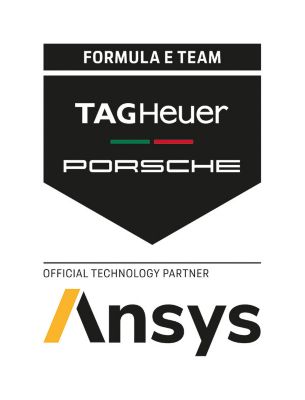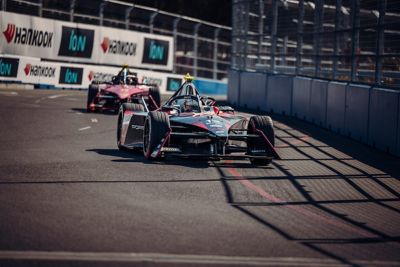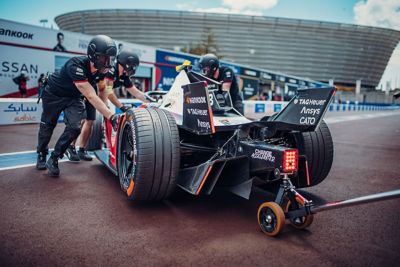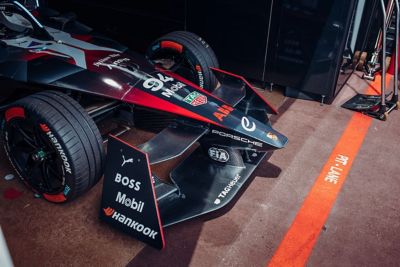-
United States -
United Kingdom -
India -
France -
Deutschland -
Italia -
日本 -
대한민국 -
中国 -
台灣
-
Ansys si impegna a fare in modo che gli studenti di oggi abbiano successo, fornendogli il software gratuito di simulazione ingegneristica.
-
Ansys si impegna a fare in modo che gli studenti di oggi abbiano successo, fornendogli il software gratuito di simulazione ingegneristica.
-
Ansys si impegna a fare in modo che gli studenti di oggi abbiano successo, fornendogli il software gratuito di simulazione ingegneristica.
-
Contattaci -
Opportunità di lavoro -
Studenti e Accademici -
Per Stati Uniti e Canada
+1 844.462.6797
ANSYS BLOG
May 15, 2023
TAG Heuer Porsche Formula E Team Races Toward Efficiency with Simulation
As we amp up to an all-electric automotive future, original equipment manufacturers like Porsche are testing out the agility of some of the fastest, lightest vehicles ever made. There’s really only one competition on the planet in which you can see electric cars speeding down city streets for 45 minutes at up to 200 miles per hour, and that’s the ABB FIA Formula E World Championship.
Formula E racing isn’t just about power; it’s about how efficiently you use it to win a race. Here, being the fastest coincides with being the most efficient, and losses are measured not only in kilowatts, but in milliseconds. To meet this all-electric challenge, every aspect of a Formula One racer has been rethought, redesigned, and rebuilt for high-performance, efficient, sustainable racing.
To realize a winning level of efficiency, Gen3 electric powertrains must be optimized over a wide range of operating points. These performance requirements extend to different tracks on multiple continents over varying terrains, where a perfect combination of efficiency and speed rules the day.


The Porsche 99X Electric taking a lap at the 2023 Cape Town E-Prix. TAG Heuer Porsche Formula E Team driver António Félix da Costa went on to win the race.
Ongoing Optimization Leads to Smarter Energy Consumption
Leonard Mengoni at Porsche Motorsport understands the challenges of ABB FIA Formula E racing and the impact efficiency will have on electric race car development in the future. He is one of several design engineers involved in the ongoing optimization of the Porsche 99X Electric Gen3 Formula E racer’s electric powertrain. He uses simulation as a guidepost involving any number of variables to benchmark and to help maintain the highest level of efficiency during a race.
“During a race there can be different scenarios, like a safety car or full course yellow, that result in additional laps that must be completed,” says Mengoni. “As soon as such an event occurs, the target for energy consumption of the driver is adapted. We also monitor our competitors to estimate which strategy they are using and adapt our strategy to that.”

TAG Heuer Porsche Formula E Team pit crew zooms in on the technical details to support Porsche 99X Electric at the 2023 Cape Town E-Prix.
Mengoni’s team routinely looks to detailed models of powertrain components to identify opportunities for optimization and lightweighting of the Porsche 99X Electric’s electric machine and its inverter. From there, the team makes incremental changes to achieve the highest level of efficiency over an entire race. Having an efficient powertrain helps the TAG Heuer Porsche Formula E Team during the race, as they can use the amount of energy saved through optimization to overtake their competitors.
“By comparing our pre-event simulation data with the data we gained on the track during practice sessions, we can evaluate if our estimations on track conditions, such as grip or temperatures, match reality,” says Mengoni. “Using data to analyze these differences and root out causes enables us to improve our simulation models and adapt our overall strategy before the race.”
Ansys Puts Porsche’s Powertrain Concepts to the Test
The latest iteration of the Porsche 99X Electric Gen3 car is a significant departure from its predecessor. It has a higher power drive and energy recuperation, but less battery capacity, which required the team to find the right balance between high power density and high efficiency.
Before any testing and validation activities begin, possible hardware and software powertrain modifications are simulated to judge their potential. It’s in the predevelopment stage that simulation plays a particularly critical role, as there are many technologies and powertrain topologies to choose from. Determining the most promising approach before testing ensures the team uses testing time as efficiently as possible.
Ahead of season nine, the TAG Heuer Porsche Formula E Team looked to the increased power level of the car as motivation to investigate a broad range of powertrain concepts. Having initially analyzed different powertrain variants, the team could not decide on a path to follow. So, revisiting their analysis with simulation, considerable time was given to drill down further on the details around how loss is generated in the components and how that loss could be modeled in the most efficient manner.

Waiting in the pit lane at the 2023 Cape Town E-Prix with the Porsche 99X Electric.
The TAG Heuer Porsche Formula E Team did a lot of iterative work using simulation to develop a powertrain that is efficient under virtually every condition. Specifically, the team uses Ansys Maxwell 2D and 3D for electric machine simulation, as it offers many degrees of freedom and number of parameters in the model that are estimated from the data. Support from Ansys experts enabled the TAG Heuer Porsche Formula E Team to incorporate additional loss models and take the switched output voltages of the inverter into account.
Ansys Motor-CAD was also used to evaluate the thermal performance of the electric machine, as the team found it delivers quick but precise results. For the inverter, the team relied on a mixture of analytic calculations and an inverter model in Ansys Twin Builder for more detailed calculation and validation of its designs.
How Simulation Measures Up During Validation
In a racing environment, every simulation must be validated by measurement. Whenever simulation is used during predevelopment, the team tries to validate it as quickly as possible to make sure they include all relevant physical effects. Overall, more accurate validation with simulation means fewer measurement activities are required in the long run, as long as the technology and materials under investigation are within a certain variance.
“We have to use simulation to get a precise evaluation of which concept or technology is beneficial for the new powertrain before the season begins,” says Mengoni. “By comparing our simulation results with measurement data from the test bench and track, we can further improve our models. It’s important for us to get a good grasp on what modification is needed upfront, as during the season, we can only improve the car via software updates.”
ABB FIA Formula E racing is paving the way to an all-electric future. Discover how Ansys solutions are helping automotive manufacturers gear up for it.










